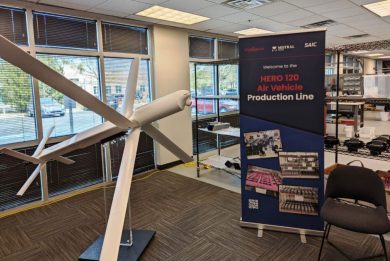IDEX 2025 – Kalashnikov presents its latest attack UAVs
The ongoing Russian-Ukrainian military conflict is characterized by the massive use of unmanned aerial vehicles (UAVs) of various types in the Ukrainian theatre of military operations (TMO). The results of combat use of unmanned aerial vehicles are taken into account when creating new or improving existing UAV models. In particular, the Kalashnikov Concern is implementing a number of programmes on its own initiative to create advanced UAV models, some of which are presented for the first time at IDEX-2025
Among the new developments of Kalashnikov are loitering munitions (LM), which have demonstrated high combat effectiveness in the Ukrainian TMO. In particular, the small and medium-class KUB-2-E guided loitering munitions (UBB for Upravlyaemyi Barrazhirueshiy Boepripas in Russian language) were unveiled in Abu Dhabi. These munitions were jointly developed by JSC Concern Kalashnikov and the Scientific and Production Association Izhevsk Unmanned Systems (NPO IzhBS, part of the Concern Kalashnikov).
The KUB-2-1E small LM is designed to destroy enemy manpower (up to an individual serviceman) and unarmoured military equipment, while the bigger KUB-2-2E medium-class LM has a wider range of applications, as it was designed to strike not only the aforementioned targets but also launch sites for UAV systems, helicopter bases, as well as lightly armoured military equipment.
The aerodynamic design and layout of KUB-2-E munitions are similar to the American Switchblade LM produced by AeroVironment, however Russian LMs are launched from an inclined catapult and not from a container tube launcher. Both LMs have square section fuselage with a low straight trapezoidal wing and a high trapezoidal horizontal tail unit. Their propulsion is provided by an electric motor located at the rear, which activates a two-blade pushing propeller, the battery being located around the centre of gravity. The aerodynamic design of the KUB-2-E provides the necessary manoeuvrability in the final segment of the trajectory.
The KUB-2-1E has a take-off mass of 12 kg and it is fitted with a 3.9 kg thermobaric warhead. It can reach a maximum speed of 150 km/h, maximum flight time being over 20 minutes for a range of more than 20 km, the UAV flying at a maximum altitude of over 2,000 metres.
The bigger KUB-2-2E has a mass at take-off of 14.5 kg and is fitted with a 4.6 kg thermobaric warhead. It can reach targets at over 40 km, maximum flight time being over 25 minutes while cruise speed is around 150 km/h, with a maximum flight altitude of 2,000 metres,
A day/night optical-electronic system is installed in the nose both munitions, allowing operators to guide them towards moving targets even in adverse weather conditions, such as in presence of fog, smoke and dust, the company claims, which indicates the presence of a thermal imager. KUB-2 munitions can withstand wind speeds near the ground of up to 15 m/s, can fly in contested environment with passive and active interference by the enemy, their temperature flight envelope going from -40°C up to +50°C.
At the Abu Dhabi exhibition Kalashnikov also presenting unveiled its super-manoeuvrable guided munitions (UB, Upravlyaemyi Boepripas in Russian language) designed to be used in swarm attacks, which are part of the new reconnaissance and strike system based on KUB-SM (SM for Super Manoeuvrable) LMs.
The system is composed of a 6×6 armoured combat vehicle with a double crew cabin at the front, with two access doors each side, hosting the four man-crew, followed by the launch container carrying the munitions, each one in its launch tube, and finally by the command post. A total of 16 launch tubes can be seen; 14 host the LMs, while two host the reconnaissance/relay UAV (UAV-R), the latter intended to reconnoitre the area of interest and relay video feed and information to the command post. When LMs are in the area the UAV-R can also act as radio relay to forward their video feed to the control station.
Although no details were provided, the KUB-SM loitering munitions seem to have a square-section front fuselage tapered at the rear; wings are hinged at the top and folded backwards, swinging forward after launch to take a swept wing position. The tailplane seems of the V-type, both semi-planes swinging forward to be located under the fuselage when the system is hosted in its launch pod. The electric motor at the rear activates a two-blade pushing propeller, which blades are folded when in the pod. Both types of unmanned air vehicles have are based on the same flying platform and are launched from their pod under gas pressure.
The pod with the LM has a mass of 55 kg, while that with the UAV-R has a mass of 65 kg. LMs carry a 5 kg multirole warhead, no more details being provided, terminal guidance being either TV or IR homing, while navigation is carried out on GNSS grids. Both the attack and reconnaissance versions of the UAV have a cruise speed of 100 km/h, a maximum flight range of 45 km, and fly between 100 and 2,500 metres altitude. The data link has a 40 km range, well sufficient considering that both types of UAVs will not go straight towards the target.
The KUB-SM is designed to conduct mobile combat operations and destroy unarmoured and lightly armoured military equipment, elements of divisional and lower echelon command posts, anti-aircraft missile formations, including vehicles with electronic warfare equipment, air defence and missile defence systems, electronic reconnaissance and electronic warfare assets such as air defence, counter-battery radars, ground moving target reconnaissance radars, rear support facilities, launch sites of enemy UAV systems, enemy fixed and rotary wing aircraft when parked on airfields outside shelters, and finally manpower in personal armoured carriers.
The KUB-SM complex ensures combat use of Super Manoeuvrable guided munitions day and night, in standard and difficult meteorological conditions, in winds with gusts of up to 15 m/s.
Photos by N. Novichkov and P. Valpolini








